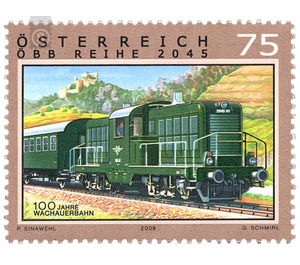100 years - Austria / II. Republic of Austria 2009 - 75 Euro Cent
Theme: Traffic, Transportation & Mobility
| Country | Austria / II. Republic of Austria |
| Issue Date | 2009 |
| Face Value | 75.00 |
| Edition Issued | 500,000 |
| Printing Type | combination printing |
| Stamp Type | Commemorative |
| Item Type | Stamp |
| Chronological Issue Number | 2154 |
| Chronological Chapter | OOS-OE2 |
| SID | 189111 |
| In 63 Wishlists | |
Since 1909 the romantic railway line leads through the Danube landscapes Wachau, Nibelungengau and Strudengau and thus connects the villages of Krems with Grein and St. Valentin. The varied ride leads through the middle of the vineyards, past historical places, and always follows the course of the Danube. The passing landscape is characterized by natural beauties, such as the terraces of ancient vineyards or numerous cultural monuments that invite you to linger and give an interesting insight into the rich past of this enchanting piece of Austria, which has been declared a UNESCO World Heritage Site. On the history of the Wachau Railway: After a long planning phase, the project was first presented in 1897; Only seven years later, in the winter of 1904/05, did the first political ascent. In 1907, the construction was finally awarded to the planning concessionaire Dr. Awarded Rudolf Mayreder. To finance the costs of 17.4 million crowns, 2.1 million crowns had to be raised by subscribing for ordinary shares, the remainder through a state-guaranteed loan. On 2 December 1909, the route Krems - Grein was festively opened by a special train and on December 4, the scheduled operation started. The installation of the route took place over the flood marks of 1889; Thus, from the Donauuferbahn (as its real name) was a traffic-safe replacement route for the Empress Elisabeth Railway or the old Wachau Street. Of course, this resulted in remarkable artificial structures: More than 1.6 million cubic meters of rock had to be moved, mostly by blasting. 18 tunnels with a total length of 3145 meters were built, the shortest is at the Teufelsmauer near Spitz and measures only 13 meters. The many side valleys were translated by 14 large bridges, iron constructions complement the numerous stone buildings. The construction of the Wachau Railway was also to be the first test for the then still young monument protection movement. For the first time in the history of railway construction, monument protection and landscape management were equal partners alongside material interests. On the part of "K.K. Central Commission for the Study and Conservation of Art and Historical Monuments "was commissioned by the protector, Archduke Franz Ferdinand, the architect and painter Rudolf Pichler, to take care of the interests of monument protection.


